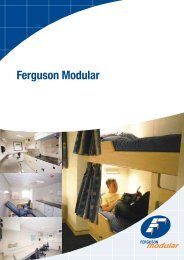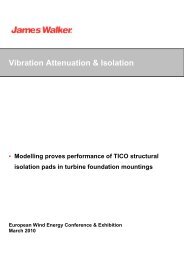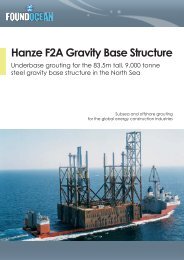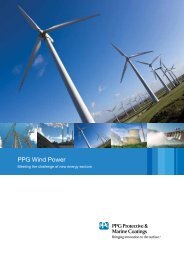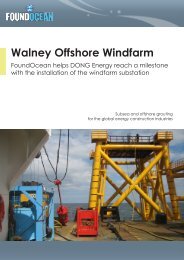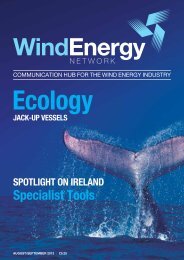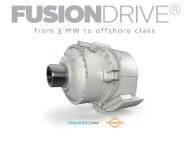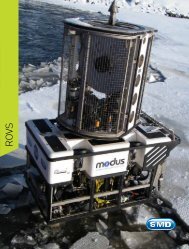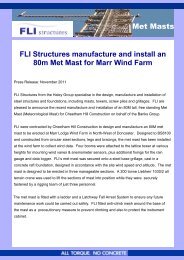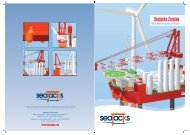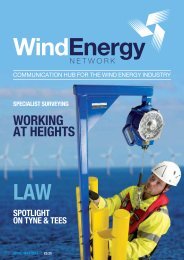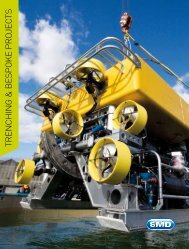JUNE/JULY 2013 | £5.25 - Wind Energy Network
JUNE/JULY 2013 | £5.25 - Wind Energy Network
JUNE/JULY 2013 | £5.25 - Wind Energy Network
Create successful ePaper yourself
Turn your PDF publications into a flip-book with our unique Google optimized e-Paper software.
LEAD ARTICLELEAD ARTICLEConcreteversusSteelTo date the Government andoffshore wind industry hasconcentrated its energies onexpensive steel piles and jackets.It appears they are reluctant to usea cheaper and superior systemoffered by concrete Gravity BaseStructures (GBS).In order to meet carbon reductiontargets no-one, either in Government orIndustry, appears to have consideredthe true through-life costs and longtermimpact of steel structures.We are, therefore now in a situationwhereby any area shallow enough toconstruct in steel has been substantiallydeveloped using pile-supported windturbine generators, ignoring the factthat wind farms could be constructedfar more economically further offshoreand away from view, fishing groundsand shipping lanes.A more considered approachIt therefore seems timely for amore considered approach to beadopted as future large offshore winddevelopments will be about scale, lowunit cost and repeatability. The offshorewind supply chain will be required todeliver a large number of foundationsin a very short timeframe, ensuringsafe and cost-effective transportation,installation and maintenance.Gravity Base Structures (GBS)Concrete GBSs are cheaper and easy toinstall, have better fatigue characteristics,are easier and cheaper to maintain andcan be removed relatively easily thusobviating legacy problems.Self-installing GBSsSelf-installing GBS are easy to installand avoid the very heavy cost ofcomplex installation vessels with theirattendant high project risk. These factsare apparently not clearly understoodby Government, who provide little realsupport for the development of thispotentially all-British technology.Understandably GBS is lobbied againstby steel pile and tower system suppliersand the owners of the expensive andhighly profitable ship operators. However,if the <strong>Wind</strong> Industry in general and thedevelopers in particular were to fullyappraise GBS, these systems would veryquickly become the industry norm.Mass productionGBS could easily be made andcommissioned with their <strong>Wind</strong> TurbineGenerators (WTGs) fitted and ready fordeployment using mass production linetechniques at several centres around theUK. This system, incidentally, would createsubstantial employment within the supplychain and avoid importing steel structuresfrom Europe.“Float and Sink” technologyIt is certainly very thought-provokingto envisage WTGs being towed froman inshore construction site on theirself-floating foundation structures, fullyassembled,tested, 90% commissionedthen installed using standard marinetugs, operating at a fraction of the costof complex and very expensive specialistinstallation vessels currently employed andbeing able to be deployed within hours. Atrue “Float and Sink” technology.Sub-stations can also be assembled andcommissioned in-dock and deliveredin the same way. The only off-shorecommissioning would be running andconnecting the cables between installedunits; such a scenario should be today’sreality.“Plug and Play” scenario<strong>Wind</strong> farms containing hundreds of GBSbasedWTG and sub-station units couldbe easily developed and made operationalwithin a minimum time-frame; offering atrue “plug and play” scenario in 60 metresof water and beyond.To give an idea of what could be achieved– imagine the allies trying to build MulberryHarbour on D-Day using steel piles. Theoutcome would have been very different.Using GBS technology Mulberry went inovernight and was crucial to victory.DeploymentThe concrete GBS systems are stableduring tow even with large (10mW)WTG’s. Deploying them in the North &Irish Seas would require very little or nosea-bed preparation using specialisedintegral foundation pads; where scourprotection is required, this too can befitted to the GBS in-dock on pre-installedframes which are deployed once the GBSis sited.Operation and maintenanceMajor re-fits, upgrades and severedamage maintenance on the units can befacilitated onshore by re-floating the GBSand bringing it back to port; replacingimmediately with another WTG.Reduced long term costs andrecyclingThis system will result in the reductionof long-term maintenance cost and willensure that over time the design life on allcomponents could be maximised in full.Concrete structures are also benign insea environments and have a very longdesign life. However, if required they canbe re-floated and returned to port cheaplyin order that the WTG and GBS can beeconomically recycled, leaving no legacyimpact on the seabed.Sustainability without subsidyGBS technology is almost certainly crucialfor the long-term sustainability of windfarm development further offshore and indeep water.Large wind farm developments could, inthe very near future, be commissionedquickly and economically far offshore.They even raise the possibility of greenenergy without subsidy!David BoneOcean Resourcewww.oceanresource.co.ukClick to view more infoAbout Ocean ResourceOcean Resource is skilled in the design and development of Gravity Buoyant Structures (GBS) for OffshorePlatforms, Tower Structures and large (4000 tonnes) Oil Field Control Buoys. Ocean Resource-designed GBSs of upto 25,000 tonnes have been operational in the North and Irish Seas for more than twenty years.04 www.windenergynetwork.co.ukwww.windenergynetwork.co.uk 05



